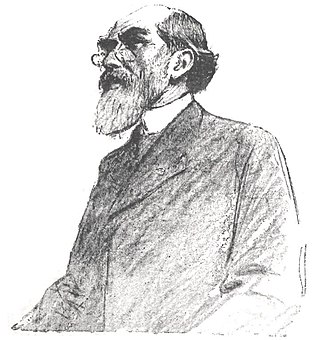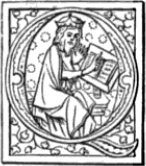
Marie-Paul-Hyacinthe Meyer, was a French philologist.
The Black Knight appears in various forms in Arthurian legend.

Raoul de Houdenc was the French author of the Arthurian romance Meraugis de Portlesguez and possibly La Vengeance Raguidel. Modern scholarship suggests he is probably to be identified with one Radulfus from Hodenc-en-Bray. Raoul de Houdenc was esteemed as a master poet in the ranks of Chrétien de Troyes by Huon de Méry.
Jaufre is the only surviving Arthurian romance written in Occitan. A verse romance approximately 11,000 lines long, its main character is equivalent to Sir Griflet son of Do, a Knight of the Round Table known from other literature. Translations of Jaufre were popular on the Iberian peninsula; a version of the tale even exists in Tagalog, the language of the Philippines.
Renaud de Beaujeu is the name of a medieval French author of Arthurian romance. He is known for only one major work, Le Bel Inconnu, the Fair Unknown, a poem of 6266 lines in Old French that was composed in the late-twelfth or early-thirteenth century. Renaud left us his name at the end of this poem: 'Renals de Biauju, or, as usually written, Renaud de Beaujeu', In modern French he is known as Renaut de Beaujeu. Le Bel Inconnu survives in only one manuscript: Chantilly, Bibliothèque du Château, 472 (626).
Geneviève Hasenohr is a French philologist and prolific scholar of medieval and Renaissance French literature. She has authored or contributed to more than forty books, written at least fifty academic articles and reviews, and prepared numerous scholarly editions.

The Livre de chasse is a medieval book on hunting, written between 1387 and 1389 by Gaston III, Count of Foix, also known as Fébus or Phoebus, and dedicated to Philip the Bold, Duke of Burgundy. Fébus was one of the greatest huntsmen of his day and his treatise became the standard text on medieval hunting techniques. It was described by scholar, Hannele Klemettilä, as "one of the most influential texts of its era".

Raoul Girardet was a French historian who specialized in military societies, colonialism and French nationalism. As a young man he was involved with the right-wing Action Française movement. He was not antisemitic, but was passionately nationalistic. During World War II he supported the French Resistance. Later he supported the OAS struggle against giving independence to Algeria.

Anne de Graville or Anne Malet de Graville (c.1490–c.1540) was a French Renaissance poet, translator, book collector, and lady-in-waiting to Queen Claude of France. She hailed from one of the most prominent families in the country, and overcame scandal to become a well respected literary figure at the royal court. In addition to authoring two texts, she was an avid collector of books and manuscripts.
Anne Berthelot is a French professor of Medieval French literature and studies. She is currently teaching at the University of Connecticut since 1990.
Meraugis de Portlesguez is a late 12th-century or early 13th-century Arthurian romance by Raoul de Houdenc. It consists of 5938 octosyllabic verses. Its protagonist Meraugis also briefly appears as a character in Raoul's La Vengeance Raguidel.
Guillaume d'Angleterre is a 12th-century epic poem in Old French, consisting of 3310 lines. The author identifies himself as Crestiiens on the first line of the poem, which has caused a great deal of debate in the romance philological community as to whether the author is Chrétien de Troyes.
L'âtre périlleux is an anonymous 13th century poem written in Old French in which Gawain is the hero. The name comes from just one of the adventures Gawain takes part in. Forced to spend the night in a chapel in a cemetery, he encounters a woman who has been cursed and is forced to spend the night with a devil each night. He defeats the devil and liberates her. The story draws on influences from other Arthurian romances, such as those of Raoul de Houdenc and Chrétien de Troyes.

Michel Zink is a French writer, medievalist, philologist, and professor of French literature, particularly that of the Middle Ages. He is the Permanent Secretary of the Académie des Inscriptions et Belles-Lettres, a title he has held since 2011, and was elected to the Académie française in 2017. In addition to his academic work, he has also written historical crime novels, one of which continues the story of Arsène Lupin.
BnF Français 794 is a mid-13th century French manuscript, and one of only two manuscripts to contain the five romances of Chrétien de Troyes, the other being BnF Français 1450.
La Mule sans frein or La Demoiselle à la mule is a short romance dating from the late 12th century or early 13th century. It comprises 1,136 lines in octosyllabic couplets, written in Old French. Its author names himself as Païen de Maisières, but critics disagree as to whether this was his real name or a pseudonym. La Mule is an Arthurian romance relating the adventures, first of Sir Kay, then of Sir Gawain, in attempting to restore to its rightful owner a stolen bridle. It is notable for its early use of the "beheading game" theme, which later reappeared in the Middle English romance Sir Gawain and the Green Knight. It is sometimes seen as a skit or burlesque on earlier romances, especially those of Chrétien de Troyes, but it has also been suggested that it might have been written by Chrétien himself.
Jehan de Paris is an anonymous prose romance written at the end of the 15th century, probably around the years 1494–1495.
Henri-Victor Michelant was a French librarian, romanist and medievalist.
The esplumoir Merlin is a place mentioned in the Arthurian legend in relation with the magician Merlin. Its nature remains uncertain, but it probably relates to a metamorphosis into a bird. It is presented as a hut, a tower or a high rock and is sometimes likened to the Hotié de Viviane, a megalithic site in Brittany. It is also mentioned in Raoul de Houdenc's narrative poem, Meraugis de Portlesguez.
"The knight who could make cunts speak" is a French fabliau. Seven versions of it remain, including one in MS Harley 2253.